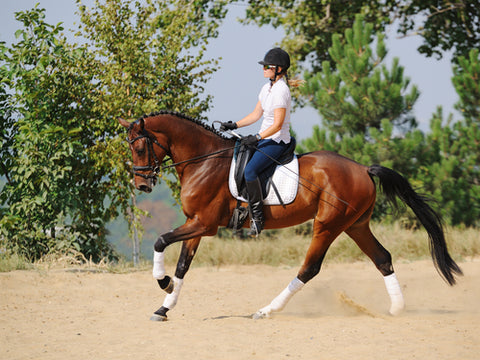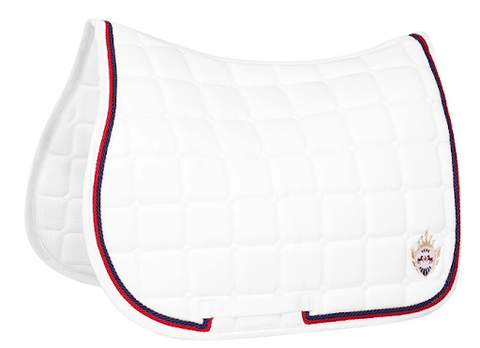The equine industry is full of trends, just like every other sport. Some trends are for fashion and some have to do with the health of the horse. There are some trends that are good and some should never see the light of day again (like fringe, side zip breeches and helmets without chin straps).
Not all trends are for fashion. Some trends are out of the good of the horse (or so we think). One trend has been layering saddle pads in hopes to offset an ill-fitting saddle or to cushion the horse’s back as much as possible. This has good intentions, but is not always effective and can, in some instances, do more harm than good.

Because a horse saddle is in direct contact with moving parts and sensitive skeletal and soft tissues, it must fit the horse properly as to not cause pain and atrophies. So, why shouldn’t your saddle pad? A saddle pad must also compliment and work with your horse’s back just as a saddle would.
What do I need a saddle pad for, anyways?
The function of a saddle pad is to provide some cushion between the leather of the saddle and prevent skin and hair irritation. Saddle pads also provide protection to the saddle leather; if the saddle was in contact with the horse’s skin and hair, it would shorten the lifespan of your most prized tack piece!
What are the different measurements for a saddle pad?
There are a few different parts to look at when picking out a saddle pad. First is the “drop”; this is the length from just behind the withers of the pad straight down to the bottom trim. The spine is at the top that splits the pad itself in half. The spine should closely resemble the curvature of your horse’s spine in order to prevent tight and gapping fabric when underneath the saddle.
The width (or length) of the pad is also important because it must stick out slightly farther than your saddle at both ends. This can be a little more difficult with larger saddle sizes as well as saddles with extremely forward flaps.
What kind of saddle pad do I need?
The type of saddle pad that you need depends on the type of saddle that you have. There are saddle pad types and needs for every discipline.
Saddle pads outline the basic shape of the saddle used and each differ in shape, thickness and details/colors.
All-Purpose: An all-purpose saddle is generally used for a variety of disciplines and needs to have a middle-of-the-road shape and features so that it can serve a purpose in several disciplines such as low-level dressage, hunt seat equitation and the low-level jumper ring.
The saddle pad must appropriately follow the outline of this saddle type. These are generally quilted and designed with or without trim. These saddle pads have close to equal measurements in length and drop.

Dressage: A dressage pad cuts around a dressage saddle. A dressage saddle has longer flaps to accommodate a longer leg position, so does the saddle pad for it! Dressage saddle pads are more square-shaped and longer in the drop, to accommodate for the longer saddle flap shape.
Close Contact: Close contact saddle pads are made for close contact saddles and usually are cut-out shaped to the saddle in order to have less fabric. Close contact saddles can be mono flap as well as very forward flaps to support a rider’s leg over fences.
Technical Features of a Saddle Pad:
Saddle pads have changed throughout the years as riders and product developers have realized what aspects are important and what features would benefit the horse’s experience when tacked up. Technical aspects of saddle pads can be shock absorption, moisture-wicking abilities and saddle fit adjustments.
Shock Absorption: Saddle pads that offer shock absorption are made to soak up the concussive forces from the rider’s weight and block them from reaching the horse’s back. This is to create a soft, comfortable horse. If the horse can feel every little inconsistency in the rider’s unbalanced and rigid seat, it will be more difficult for the horse to reach from underneath and lift its back in a proper carriage and stride.

There are many types of fill materials used to achieve shock absorption and all range in price and effectiveness from gel, fleece and polyester/cotton to reindeer fur. There is an interesting article to read about the differences between these materials and their effectiveness here. Ultimately, the choice is up to the rider’s budget and the confidence in their seats.
Moisture Control: Moisture-wicking capabilities are one of the more popular technical aspects that people look for when searching for their next saddle pad.
Why is moisture control important in English horse saddle pads?
When a horse sweats, it releases moisture that has trapped heat along with metabolic waste to be carried away from the body. Ideally, this moisture should evaporate off of the body, but with a non-porous wall (such as a saddle pad) in the way, this natural mechanism cannot happen.
Now, the moisture does not have anywhere to go but sit underneath on the horse’s skin. A well-working moisture control system in a saddle pad should pick up that released moisture away from the horse’s skin to take the heat away. This is just another reason to invest in quality English saddle pads.
Moisture control is also important because of fungus (no, it isn’t so fun). When moisture is allowed to remain on the horse’s back, it creates a wet environment that is suitable for unwelcome guests such as bacteria and fungi to live. This is also the number 1 reason to clean/wash your saddle pads periodically. Take a stiff body brush and begin to remove as much solid hair and grime as possible and lay pad upside down to expose wet underside to the sunshine to dry.
This is a good policy to keep after every ride as dry materials will discourage bacteria and fungi to produce further. Washing saddle pads once in a while provides a good deep clean; make sure to do this in your barn’s washing machine and not your own! (you do not want to find out why!)
Saddle Fit Adjustments: This can be a tricky game of balance. Many people layer up saddle pads in efforts to push a poorly fitting saddle off the horse’s back. This actually does the exact opposite. Starting with a correctly fitting saddle is the solution to this problem. With weighing pressure from a clicked girth and add an extra 100+ pounds for a rider, this doesn’t do much in the way of pushing the saddle up, in fact, it makes it worse.
A slightly wide fitting saddle pad can potentially be corrected with a regular pad and a half pad. Some companies offer half and full pads that are specifically for corrective fitting. Some pads have pockets for strategically placed “shims”. These are used to build up areas where there is gapping only, not to relieve pinching. Some are heat activated to provide memory foam-like conformation to the horse’s back and the saddle. Fleece is also known to provide cushion and take up some space in a slightly wide saddle as well.
All in all, saddle pad fit can be just as important as saddle fit. Make your saddle pad work with your horse and provide as much comfort as possible. Remember that starting with a well-fitting saddle is the first step to a happy horse!




